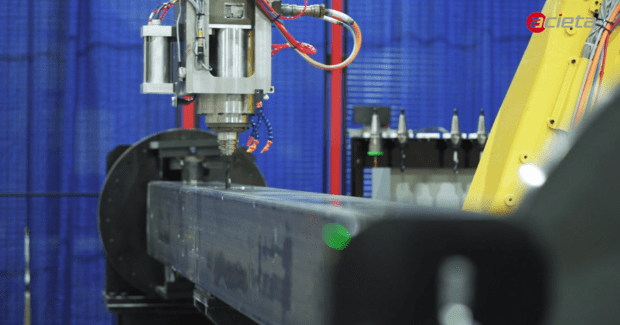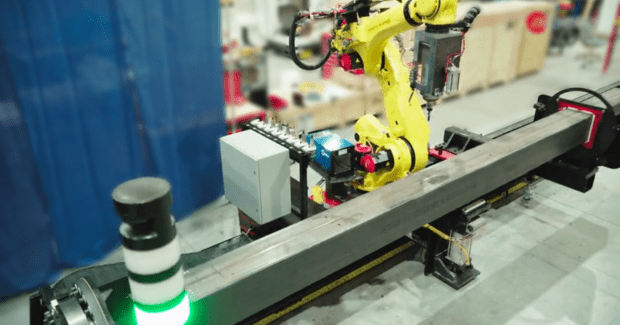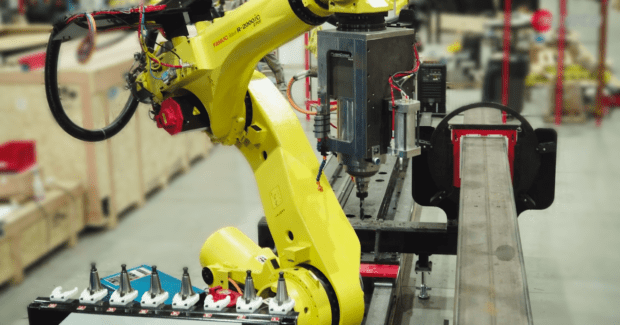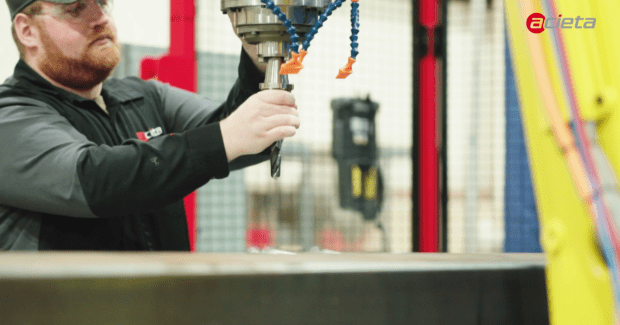A Faster, More-Accurate Way to Tap and Drill Structural Steel
A heavy equipment manufacturer is using a 6-axis robotic arm equipped with a drilling spindle to very precisely make holes in structural steel up to 1 inch thick. The solution is one-third the cost of traditional drilling but performs many other applications and requires just one operator.
Posted: January 5, 2021
ADVANCING AUTOMATION COLUMN
BY JOHN BURG
Until very recently, fabricators have had limited options for drilling holes into large, thick structural steel like tubing, angle iron and channel iron. The most likely choices were radial-arm drills, magnetic-based drills, thermal processes such as plasma or oxy-fuel, and multiaxis machine tools.
However, thanks to increased payload capacities and technological advancements, robots can quickly drill and tap small holes with a high degree of accuracy. The result is an extremely flexible automated system that pays for itself in 18 to 24 months.
Downsides to Traditional Drilling Methods
Although gantry-style systems outfitted with a thermal process torch are cost-effectively and precisely cut holes larger than 1 inch in diameter, they have very limited accuracy for smaller openings. If tapping is required, the component must be moved to a secondary process.
A manual radial-arm drill is more accurate, but slower and more labor-intensive. Depending on the volume of work to be done, it may require two shifts of four employees to move, measure and adjust the placement of large, heavy steel components. There’s potential for injury and human error during the process, especially later in a shift when employees are fatigued.
Machine tools are extremely accurate for drilling holes up to 3 inches in diameter, but the capital required to buy a large-capacity machine can be difficult to justify if it’s dedicated solely to drilling applications. Plus, the machines consume a lot of floor space.
A Real-Life Example
We recently helped develop a robotic system for a heavy equipment manufacturer that very precisely drills holes 0.5-inch to 1 inch in diameter and taps 5/8-11 threads without the use of tension and compression holders. The solution is one-third the cost of a machine tool of equivalent size, but can perform other applications, such as grinding, chamfering, and thermal cutting; and requires only one operator. In addition, the company is able to fully customize and adjust the system’s capabilities on nearly any drillable material.
The system comprises a Fanuc R-2000iC/270F 6-axis robot outfitted with a PushCorp Inc. servo-controlled drilling spindle with automatic tool change capability using standard BT40 toolholders stored in an adjacent rack. The robot can bring the spindle to the operator, which makes replacing spent tools convenient for the operator.
The operator uses a hoist to place the steel component into the fixturing and chooses the drilling program on the operator’s panel. The robot drills each hole to the correct size and location so holes on opposite sides of a tube or other component align. When the robot needs to access a different side, the fixturing system automatically rotates the component.
The entire process is about four times faster than a traditional manual material-handling-and-drilling system, and much safer for employees to operate.
Technological Improvements Expand Applications
Most metal manufacturers don’t know structural steel drilling and tapping can be automated because, until recently, the technology wasn’t advanced enough. Five years ago, robots weren’t capable of providing the required rigidity.
However, advancements in robot rigidity and axis drive systems have made robotic applications possible. One of the highest-payload robots in Fanuc’s R-2000 product line, the iC/270F lifts 595 pounds (270 kg) and reaches 8.75 feet (2,655 mm).
There’s an assumption that robots are extremely expensive and can’t be financially justified. However, robotic systems aren’t limited to drilling and tapping. If a fabricator wants to do further cutting or welding on the same piece of structural steel, the robot can be outfitted with a plasma or welding torch. The investment need not sit idle between drilling sessions, further lowering its cost-per-use ratio.
Robots are much more accurate than humans, which increases throughput. They lower material-handling costs and waste by minimizing scrap, and free employees to be allocated to higher-value work.
For large components that must be rebuilt or modified from an existing design, automatic systems offer a feature that machine tools and manual systems can’t provide. If a hole needs to be drilled in relationship to an existing detail, such as a welded section or another hole, the robot can use machine vision to locate the placement in relationship to other details on the part. Employees don’t have to measure and re-measure, a manual process with high potential for costly errors.
Some manufacturers mistakenly assume they’ll need to hire a technical expert to program such capability. However, robots have intuitive interfaces with touchscreens and easy-to-understand graphics that simplify programming and operation even for less-skilled employees. In many cases, operators need minimal training. Programming robots with offline programming systems is a well-established process as well.
With automated applications for structural steel now viable, fabrication shops of all sizes have a more cost-effective way to improve precision and throughput. An experienced system integrator can help calculate whether a robot provides an acceptable return on investment for your operation.















